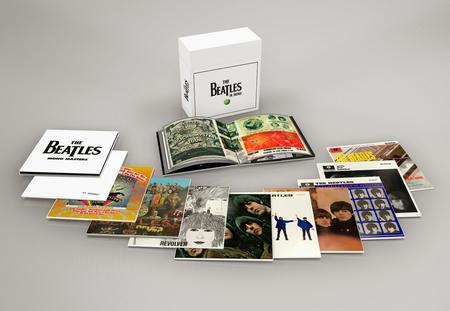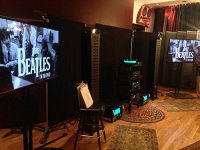- Thread Author
- #1
This year, they have decided to do it properly. I think digital re-mastering & transfer to vinyl is a joke & defeats the point of the medium which is A N A L O G.
So how is this going to compare to the 1978 Blue Box which was pressed in plants all over the world? Apparently, the 1978 BlueBox bests are the UK & Jap pressings. I never bothered with the Sydney Australia pressing.
In fact, I currently have no Beatles at all in my collection. So I'm wondering given all this time, how good is this release going to be given the tape archival? They pulled a Studer A80 to do the job, but no tubes in the middle this time.
Pre-orders now @$375 which is less than a M-/M- 1978 Blue Box.
Read on:

"The EMI representative told me that after absorbing the criticism heaped on the digitially sourced stereo box - including the extensive AnalogPlanet.com coverage, which was correctly construed as constructive criticism - the decision was made to produce the mono LPs using an all-analog mastering chain. ... Berkowitz told me that in his opinion and in the opinions of many, the mono mixes were the more important reissues and I agree." - Michael Fremer, AnalogPlanet.com. To read Fremer's full report, including his exclusive access to one of the mono mastering sessions, visit: http://www.analogplanet.com/content/beatles-get-back-mono-and-aaa-vinyl
As mentioned in the quote above, analog expert and viny guru Michael Fremer, of AnalogPlanet.com, says EMI representatives heard and responded to criticisms concerning digitally sourced mastering used to produce The Beatles Stereo Box Set on vinyl. For the mono version, the decision was made to use an all-analog mastering chain to the degree possible.
"It's important to remember that the tapes have aged - some as much as fifty years - and the monitoring, playback and mastering equipment have changed as well, even though the work was done in the very same room in which the originals were mastered. Solid state has replaced tubes in the cutting chain," writes Fremer.
The Beatles' mono albums have been newly mastered for vinyl from quarter-inch master tapes at Abbey Road Studios by Grammy-winning engineer Sean Magee and Grammy-winning mastering supervisor Steve Berkowitz. While The Beatles In Mono CD boxed set released in 2009 was created from digital remasters, for this new vinyl project, Magee and Berkowitz cut the records without using any digital technology. Instead, they employed the same procedures used in the 1960s, guided by the original albums and by detailed transfer notes made by the original cutting engineers.
Working in the same room at Abbey Road where most of The Beatles' albums were initially cut, the pair first dedicated weeks to concentrated listening, fastidiously comparing the master tapes with first pressings of the mono records made in the 1960s. Using a rigorously tested Studer A80 machine to play back the precious tapes, the new vinyl was cut on a 1980s-era VMS80 lathe.
Fremer says the lathe was equipped with a Neumann SX-74 cutter head. The originals were cut on a Scully lathe, perhaps with a Westrex cutter head.
So how is this going to compare to the 1978 Blue Box which was pressed in plants all over the world? Apparently, the 1978 BlueBox bests are the UK & Jap pressings. I never bothered with the Sydney Australia pressing.
In fact, I currently have no Beatles at all in my collection. So I'm wondering given all this time, how good is this release going to be given the tape archival? They pulled a Studer A80 to do the job, but no tubes in the middle this time.
Pre-orders now @$375 which is less than a M-/M- 1978 Blue Box.
Read on:

- The Beatles get back to mono in a limited edition 14 LP box set
- 180-gram LPs pressed in Germany by Optimal Media
- Newly remastered for vinyl from the analogue tapes by Sean Magee and Steve Berkowitz
- Cut to lacquer on a VMS80 lathe
- Exclusive 12" 108-page hardbound book with rare studio photos!
"The EMI representative told me that after absorbing the criticism heaped on the digitially sourced stereo box - including the extensive AnalogPlanet.com coverage, which was correctly construed as constructive criticism - the decision was made to produce the mono LPs using an all-analog mastering chain. ... Berkowitz told me that in his opinion and in the opinions of many, the mono mixes were the more important reissues and I agree." - Michael Fremer, AnalogPlanet.com. To read Fremer's full report, including his exclusive access to one of the mono mastering sessions, visit: http://www.analogplanet.com/content/beatles-get-back-mono-and-aaa-vinyl
As mentioned in the quote above, analog expert and viny guru Michael Fremer, of AnalogPlanet.com, says EMI representatives heard and responded to criticisms concerning digitally sourced mastering used to produce The Beatles Stereo Box Set on vinyl. For the mono version, the decision was made to use an all-analog mastering chain to the degree possible.
"It's important to remember that the tapes have aged - some as much as fifty years - and the monitoring, playback and mastering equipment have changed as well, even though the work was done in the very same room in which the originals were mastered. Solid state has replaced tubes in the cutting chain," writes Fremer.
The Beatles' mono albums have been newly mastered for vinyl from quarter-inch master tapes at Abbey Road Studios by Grammy-winning engineer Sean Magee and Grammy-winning mastering supervisor Steve Berkowitz. While The Beatles In Mono CD boxed set released in 2009 was created from digital remasters, for this new vinyl project, Magee and Berkowitz cut the records without using any digital technology. Instead, they employed the same procedures used in the 1960s, guided by the original albums and by detailed transfer notes made by the original cutting engineers.
Working in the same room at Abbey Road where most of The Beatles' albums were initially cut, the pair first dedicated weeks to concentrated listening, fastidiously comparing the master tapes with first pressings of the mono records made in the 1960s. Using a rigorously tested Studer A80 machine to play back the precious tapes, the new vinyl was cut on a 1980s-era VMS80 lathe.
Fremer says the lathe was equipped with a Neumann SX-74 cutter head. The originals were cut on a Scully lathe, perhaps with a Westrex cutter head.

